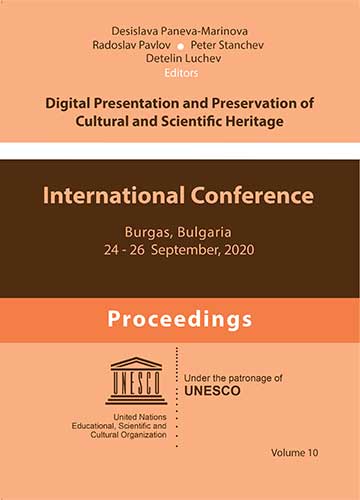RESTORATIVE: Improving Accessibility to Cultural Heritage with AI-Assisted Virtual Reality
DOI:
https://doi.org/10.55630/dipp.2025.15.6Keywords:
AI Story Telling, VR Systems, EEGbased Evaluation, Karkemish, Cultural Heritage DigitalizationAbstract
Digitalization of the cultural heritage can be considered from multiple perspectives. In this work, we present a case study based on the ancient city of Karkemish to propose a structured pipeline for developing an Artificial Intelligence (AI)-assisted Virtual Reality (VR) system. The framework outlines a roadmap for creating a user-friendly and gamified VR interface, incorporating qualitative and quantitative evaluation methods before deployment. Qualitative assessments focus on User Interface/User Experience (UI/UX) design, while quantitative evaluations utilize electroencephalogram (EEG) data to monitor cognitive and emotional responses, aiming to promote a positive user experience. Moreover, we introduce a privacy-preserving approach to ensure the user's privacy during the system interaction. The study’s aim is twofold: a) preservation and dissemination of endangered cultural heritages, and b) improving the quality of life for individuals with limited mobility (handicapped, elderly, heritage site restrictions, poverty) by enabling virtual access to cultural heritages.References
Antony, V. N., & Huang, C. M. (2025). ID. 8: Co-creating visual stories with generative AI. ACM Transactions on Interactive Intelligent Systems, 14 (3), 1–29.
Chamola, V., et al. (2024). Beyond reality: The pivotal role of generative AI in the metaverse. IEEE Internet of Things Magazine, 7 (4), 126–135. https://doi.org/10.1109/IOTM.001.2300174
Du, Q., Wei, X., Li, J., Kuang, E., Hao, J., Weng, D., & Fan, M. (2025). AI as a bridge across ages: Exploring the opportunities of artificial intelligence in supporting intergenerational communication in virtual reality. Proceedings of the ACM on Human- Computer Interaction, 9 (CSCW2), Article CSCW026, 29 pages. https://doi.org/10.1145/3710924
Eurostat. (2020, July). Ageing Europe – statistics on population developments. Statistics Explained. https://ec.europa.eu/eurostat/statistics-explained/index.php?title=Ageing_Europe_-_statistics_on_population_developments
Gutherz, G., Gordin, S., Sáenz, L., Levy, O., & Berant, J. (2023). Translating Akkadian to English with neural machine translation. PNAS Nexus, 2 (5), pgad096. https://doi.org/10.1093/pnasnexus/pgad096
Harrison, B., Ehsan, U., & Riedl, M. O. (2017). Guiding reinforcement learning exploration using natural language. arXiv Preprint, arXiv:1707.08616. https://arxiv.org/abs/1707.08616
Hawkins, J. D. (2024). Corpus of Hieroglyphic Luwian Inscriptions: Volume III: Inscriptions of the Hittite Empire and new inscriptions of the Iron Age. De Gruyter.
Kamath, P., Morreale, F., Bagaskara, P. L., Wei, Y., & Nanayakkara, S. (2024, May). Sound designer–generative AI interactions: Towards designing creative support tools for professional sound designers. In Proceedings of the 2024 CHI Conference on Human Factors in Computing Systems (pp. 1–17). ACM.
Lee, J., & Song, C. (2021). Creative art therapy as a non -pharmacological intervention for dementia: A systematic review. Journal of Alzheimer's Disease Reports, 5 (1), 387–400. https://doi.org/10.3233/ADR-201002
Li, B., Lee- Urban, S., Appling, D. S., & Riedl, M. O. (2012). Crowdsourcing narrative intelligence. Advances in Cognitive Systems, 2 (1).
Peker, H. (2016). Texts from Karkemish I: Luwian hieroglyphic inscriptions from the 2011–2015 excavations (OrientLab Series Maior 1). Ante Quem.
Peker, H. (2023). Anadolu Hiyeroglif Yazılı Belgeler 1: Geç Hitit Karkamış Krallığı Yazıtları. Ante Quem.
Riedl, M. O., & Young, R. M. (2010). Narrative planning: Balancing plot and character. Journal of Artificial Intelligence Research, 39, 217–268. https://doi.org/10.1613/jair.2858
Roemmele, M., & Gordon, A. S. (2018, March). Automated assistance for creative writing with an RNN language model. In Companion Proceedings of the 23rd International Conference on Intelligent User Interfaces (pp. 1–2). ACM. https://doi.org/10.1145/3180308.3180364
Rumelhart, D. E. (1975). Notes on a schema for stories. In D. G. Bobrow & A. Collins (Eds.), Representation and understanding (pp. 211–236). Morgan Kaufmann. https://doi.org/10.1016/B978-0-12-108550-6.50013-2
Thorndyke, P. W. (1977). Cognitive structures in comprehension and memory of narrative discourse. Cognitive Psychology, 9 (1), 77–110. https://doi.org/10.1016/0010-0285(77)90005-6
Wächter, M., Voigt, K., & Rettich, A. (2025, March 14). “Erinnerungs_reich” project of the TUD Faculty of Medicine: Museums as medicine for people with dementia offer great benefits at low cost. TU Dresden. https://tu-dresden.de/tu-dresden/newsportal/news/projekt-erinnerungs-_reich-der-medizinischen-fakultaet-der-tud-museen-als-medizin-fuer-menschen-mit-demenzbieten -hohen-nutzenbei -geringenkosten
Zhou, Y., Loh, E., Dickey, J. P., Walton, D. M., & Trejos, A. L. (2018). Development of the circumduction metric for identification of cervical motion impairment. Journal of Rehabilitation and Assistive Technologies Engineering, 5, 1–9. https://doi.org/10.1177/2055668318777984
Downloads
Published
How to Cite
Issue
Section
License
Copyright (c) 2025 Digital Presentation and Preservation of Cultural and Scientific Heritage

This work is licensed under a Creative Commons Attribution-NonCommercial 4.0 International License.



